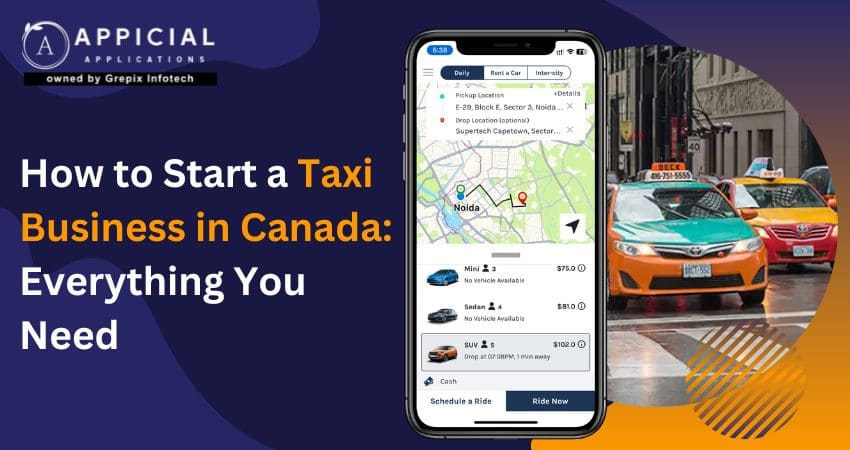
How to Start a Taxi Business in Canada: Everything You Need
Starting a taxi business in Canada presents a profitable opportunity due to the increasing demand for reliable transportation. Whether you plan to operate a traditional taxi service or adopt modern ride-hailing technology, understanding key aspects such as legal requirements, financial planning, and operational strategies is essential. From obtaining necessary permits and licenses to selecting the right business model and marketing your services, careful planning ensures long-term success. Embracing technology, such as digital booking platforms and GPS-enabled dispatch systems, can enhance efficiency and customer satisfaction. This guide will provide step-by-step insights to help you establish and grow a successful taxi business in Canada.
Starting a taxi business in Canada offers a profitable opportunity due to the rising demand for reliable transportation. Whether opting for a traditional taxi service or integrating modern ride-hailing technology, understanding legal, financial, and operational aspects is crucial. Success requires obtaining the necessary licenses, choosing the right business model, and implementing marketing strategies. Embracing technology, such as booking apps and GPS-enabled dispatch systems, enhances efficiency and customer satisfaction. Partnering with a trusted taxi app development company like Appicial Applications can provide customized solutions to streamline operations and improve user experience, ensuring your business thrives in Canada’s competitive transportation market.
1Understanding the Taxi Industry in Canada
Growth and Demand
The taxi industry in Canada has undergone significant changes over the years, adapting to new technologies and market dynamics. Despite growing competition from ride-sharing services like Uber and Lyft, traditional taxis continue to serve a vital role, particularly in areas where ride-sharing is less accessible or strictly regulated. Passengers still prefer taxis for their predictable pricing, government oversight, and accessibility. Additionally, taxis remain essential in urban centers, airports, and regions with a high demand for regulated transportation services. While the industry has faced challenges, it continues to evolve to meet the changing needs of passengers.
Traditional Taxis vs. Ride-Sharing Services
The rise of ride-sharing platforms has disrupted the traditional taxi business, forcing many operators to rethink their strategies. While ride-sharing services offer convenience and flexible pricing, traditional taxis benefit from stricter regulations, professional licensing, and fixed fare structures. To remain competitive, many taxi companies have embraced technology by integrating digital booking apps, contactless payments, and GPS tracking. By understanding the advantages and limitations of both models, taxi business owners can decide whether to operate a traditional fleet, partner with ride-sharing services or adopt a hybrid approach that combines both methods.
2Business Planning and Market Research
Identifying Your Target Market
Defining your target audience is a crucial step in building a successful taxi business. Potential customers include a diverse range of individuals, such as tourists who require reliable transportation, business travelers needing efficient airport transfers, and daily commuters seeking a convenient alternative to public transport. Additionally, elderly individuals and those with mobility challenges often depend on taxis for safe and accessible transportation. Understanding your key customer segments will help you tailor your services, pricing, and marketing efforts to meet their needs and build a loyal customer base.
Analyzing Competition
A thorough analysis of your competition will help you identify market gaps and opportunities for differentiation. Research local taxi companies and ride-sharing services in your area, evaluating their pricing structures, customer service, and technological offerings. Pay attention to customer feedback, as online reviews can provide valuable insights into what customers appreciate and what areas need improvement. By understanding the strengths and weaknesses of your competitors, you can position your business to offer unique advantages, such as superior customer service, competitive pricing, or enhanced accessibility features.
Creating a Business Plan
A well-structured business plan is essential for setting clear goals and securing funding. Your plan should begin with an executive summary that outlines your taxi business concept, mission, and objectives. Conduct a detailed market analysis to assess demand, competition, and potential challenges. Additionally, your financial plan should include estimated startup costs, operational expenses, and revenue projections to ensure profitability. Developing a strong marketing strategy is also key—this should detail how you plan to attract and retain customers through advertising, promotions, partnerships, and digital marketing. A solid business plan serves as a roadmap for success and can also be used to attract investors or secure loans.
3Legal Requirements and Licensing
Business Registration and Permits
To operate a taxi business legally in Canada, you must register your company with the appropriate federal and provincial authorities. Choosing the right legal structure is essential common options include sole proprietorships, which are easy to set up but offer no liability protection, partnerships for businesses with multiple owners, and corporations, which provide liability protection but involve more complex regulations. Additionally, many municipalities require a specific taxi business license, which varies by city and may include vehicle inspections, driver background checks, and insurance requirements. Ensuring compliance with local licensing laws is crucial to avoiding fines and maintaining a smooth operation.
Vehicle and Driver Licensing
Your taxi fleet and drivers must adhere to local regulations to operate legally. Depending on your location, drivers may need a commercial driver’s license (CDL) to transport passengers professionally. Additionally, taxis often require annual vehicle inspections to ensure safety and compliance with emissions standards. Other requirements may include obtaining taxi plates and decals to identify your vehicles as commercial transport. Ensuring all licensing and regulatory requirements will prevent legal issues and ensure smooth business operations.
Insurance Requirements
Standard personal auto insurance is not sufficient for a taxi business, as it does not cover commercial passenger transport. Instead, you will need commercial taxi insurance, which offers broader protection. This typically includes liability insurance to cover damages and injuries caused to others, collision coverage to repair or replace your taxi in case of an accident, and passenger injury protection to cover medical expenses for customers. Right insurance coverage is essential for protecting your business and your passengers.
4Choosing the Right Business Model
Owner-Operator Model
In this model, you own and drive your taxi, allowing you to manage costs effectively. This setup is perfect for those who want to start small, as it removes the necessity of hiring drivers. However, the owner-operator model limits business expansion since your earnings depend solely on your driving capacity. It is a great choice for individuals who prefer a hands-on approach with lower initial investment.
Fleet-Based Model
For those looking to scale their business, the fleet-based model offers greater revenue potential. This approach involves owning multiple taxis and hiring drivers to operate them. While this model requires a higher capital investment for vehicle purchases, driver salaries, and fleet maintenance, it allows for business growth and higher profitability. Proper management and efficient operations are key to ensuring success with a fleet-based taxi service.
5Financing Your Taxi Business
Startup Costs
Launching a taxi business requires a significant initial investment. The main expenses include purchasing or leasing vehicles, securing commercial insurance, and obtaining necessary licensing and permits. Additional costs may arise from marketing efforts, branding, and technology implementation, such as dispatch systems and mobile applications. Planning these expenses carefully ensures a smooth business launch.
Funding Options
If you require financial assistance, there are several funding options available. Business loans from banks and credit unions can provide necessary capital with structured repayment plans. Government grants and subsidies may also be available for small business owners in the transportation sector. Alternatively, seeking private investors can be a viable option, especially if you plan to scale your taxi business quickly.
6Purchasing Vehicles and Equipment
Choosing the Right Taxi Vehicle
Selecting the right vehicle for your taxi service is crucial for efficiency and customer satisfaction. Fuel-efficient models, such as hybrid or electric taxis, help reduce long-term operational costs. Spacious and comfortable interiors enhance the passenger experience, making your service more appealing. Additionally, including accessibility features, such as wheelchair ramps or extra legroom, can help attract a broader customer base and comply with disability regulations.
Essential Taxi Equipment and Technology
Modern taxi businesses rely on technology to improve efficiency and safety. A taxi meter is essential for accurate fare calculation, ensuring transparency for both drivers and passengers. GPS navigation helps drivers find the best routes and avoid traffic congestion. A dispatch system streamlines bookings and optimizes ride allocation. Security cameras provide added safety for drivers and passengers, discouraging fraud and misconduct. Investing in the right equipment enhances both operational efficiency and customer trust.
7Setting Up Operations
Hiring Drivers
If you plan to expand beyond a single vehicle, hiring qualified drivers is essential. Candidates should have valid commercial driver’s licenses, a clean driving record, and experience in passenger transport. Conducting background checks ensures reliability and professionalism. Additionally, offering training on customer service, safety protocols, and local navigation can improve service quality and customer satisfaction.
Implementing a Booking System
An efficient booking system is crucial for managing customer requests effectively. Traditional phone-based dispatch systems allow customers to book rides easily, while an online booking portal expands accessibility. Additionally, developing a mobile app can enhance customer convenience, enabling users to book, track, and pay for rides effortlessly. Implementing an efficient booking system helps streamline operations and improve service reliability.
Also Read: Best Ride-Hailing And Taxi Apps In Canada
8Marketing and Branding
Building an Online Presence
A strong online presence is crucial for attracting customers in today’s digital world. Creating a website with booking options and clear pricing helps establish credibility. Listing your business on Google My Business ensures that potential customers can find you easily. Leveraging social media platforms for promotions and customer engagement can boost brand awareness and attract more riders to your service.
Local Advertising Strategies
In addition to online marketing, local advertising can help you reach potential customers effectively. Distributing flyers and brochures in high-traffic areas or partnering with hotels, restaurants, and event venues can generate steady business. Offering discounts for repeat customers or referral incentives can also encourage customer loyalty. A combination of online and offline marketing efforts can maximize visibility and customer acquisition.
9Managing and Scaling Your Business
Handling Customer Service
Providing excellent customer service is key to retaining customers and building a positive reputation. Training drivers to be professional, courteous, and knowledgeable about local routes can enhance passenger experience. Implementing a feedback system allows customers to share their experiences and helps you identify areas for improvement. A strong focus on customer service can lead to repeat business and positive word-of-mouth referrals.
Expanding Your Fleet and Services
As your business grows, expanding your fleet can increase revenue potential. Adding more vehicles allows you to serve more customers and reduce wait times. Additionally, diversifying your services—such as offering airport transfers, corporate transportation, or wheelchair-accessible taxis can help attract a broader customer base. Scaling your business strategically ensures long-term success and market competitiveness.
Conclusion
Starting a taxi business in Canada presents a lucrative opportunity, especially with the growing demand for reliable and regulated transportation services. Whether you operate a traditional taxi service or integrate modern ride-hailing technology, understanding the legal, financial, and operational aspects is key to long-term success. By securing the necessary licenses, choosing the right business model, and leveraging technology to enhance customer experience, you can establish a strong foundation for your taxi business.
Partnering with a leading taxi app developmentcompany like Appicial Applications can give you a competitive edge by equipping your business with cutting-edge ride-hailing technology. With expertise in custom taxi app solutions, Appicial can help you create a seamless booking experience, optimize fleet management, and enhance customer engagement. From GPS-enabled dispatch systems to automated fare calculation and digital payment integrations, the right technology can set your taxi service apart in a competitive market.
As the transportation industry continues to evolve, staying ahead of market trends and embracing digital solutions will be crucial for sustaining and scaling your taxi business. With a well-thought-out strategy and the right technological support, you can build a successful, customer-centric taxi service that meets the transportation needs of your community while maximizing profitability.
FAQs
Looking out to start your own venture like Uber ? Try out our HireMe Taxi Uber Clone, the easiest way to kick-start your taxi business.
Author's Bio

Vinay Jain is the Founder at Grepix Infotech and brings over 12 years of entrepreneurial experience. His focus revolves around software & business development and customer satisfaction.
Back to blog list






